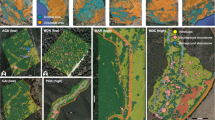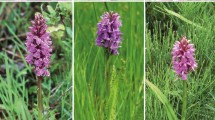Abstract
Populations at the border of ranges are considered more vulnerable than those in the center. However, some recent reviews contradict this hypothesis. We have studied the reproductive and demographic characteristics of Dactylorhiza maculata (L.) Soó at the northern border of its range (Subpolar Urals) and compared the results with data from the more southern parts of the species range. Despite the deterioration of some parameters, the species at the border of the range forms quite large, well-regenerated populations. The reproductive success of D. maculata is more dependent on specific environmental conditions than on its geographic location.

Similar content being viewed by others
REFERENCES
Eckert, C.G., Samis, K.E., and Lougheed, S.C., Genetic variation across species’ geographical ranges: The central-marginal hypothesis and beyond, Mol. Ecol., 2008, vol. 17, no. 5, pp. 1170–1188. https://doi.org/10.1111/j.1365-294X.2007.03659.x
Sexton, J.P., McIntyre, P.J., Angert, A.L., and Rice, K.J., Evolution and ecology of species range limits, Annu. Rev. Ecol. Evol. Syst., 2009, vol. 40, pp. 415–436. https://doi.org/10.1146/annurev.ecolsys.110308.120317
Lawton, J.H., Range, population abundance and conservation, Trends Ecol. Evol., 1993, vol. 8, no. 11, pp. 409–413. https://doi.org/10.1016/0169-5347(93)90043-O
Jump, A.S. and Woodward, F.I., Seed production and population density decline approaching the range edge of Ccirsium species, New Phytol., 2003, vol. 160, no. 2, pp. 349–358. https://doi.org/10.1046/j.1469-8137.2003.00873.x
Gaston, K.J., Geographic range limits: achieving synthesis, Proc. R. Soc. B: Biol. Sci., 2009, vol. 276, no. 1661, pp. 1395–1406. https://doi.org/10.1098/rspb.2008.1480
Villellas, J., Ehrlen, J., Olesen, J.M., et al., Plant performance in central and northern peripheral populations of the widespread Plantago coronopus, Ecography, 2013, vol. 36, no. 2, pp. 136–145. https://doi.org/10.1111/j.1600-0587.2012.07425.x
Garcia, D., Zamora, R., Gomez, J.M., et al., Geographical variation in seed production, predation and abortion in Juniperus communis throughout its range in europe, J. Ecol., 2000, vol. 88, no. 3, pp. 435–446. https://doi.org/10.1046/j.1365-2745.2000.00459.x
Tremblay, M.F., Bergeron, Y., Lalonde, D., and Mauffette, Y., The potential effects of sexual reproduction and seedling recruitment on the maintenance of red maple (Acer rubrum L.) populations at the northern limit of the species range, J. Biogeogr., 2002, vol. 29, no. 3, pp. 365–373. https://doi.org/10.1046/j.1365-2699.2002.00665.x
Angert, A.L., The niche, limits to species’ distributions, and spatiotemporal variation in demography across the elevation ranges of two monkeyflowers, Proc. Natl. Acad. Sci. U. S. A., 2009, vol. 106, no. 2, pp. 19693–19698. https://doi.org/10.1073/pnas.0901652106
Samis, K.E. and Eckert, C.G., Ecological correlates of fitness across the northern geographic range limit of a Pacific Coast dune plant, Ecology, 2009, vol. 90, no. 11, pp. 3051–3061. https://doi.org/10.1890/08-1914.1
Garcia, M.B., Goni, D., and Guzman, D., Living at the edge: local versus positional factors in the long-term population dynamics of an endangered orchid, Conserv. Biol., 2010, vol. 24, no. 5, pp. 1219–1229. https://doi.org/10.1111/j.1523-1739.2010.01466.x
Vakhrameeva, M.G., The genus Dactylorhiza, in Biologicheskaya flora Moskovskoi oblasti (The Biological Flora of Moscow Oblast), vol. 4, Moscow: Grif i K, 2000, pp. 55–86.
Vakhrameeva, M.G., Tatarenko, I.V., Varlygina, T.I., et al., Orchids of Russia and Adjacent Countries (within the Borders of the Former USSR). Ruggell: A.R.G Ganter Verlag, 2008.
Kuhn, R., Pedersen, H., and Cribb, P., Field Guide to the Orchids of Europe and the Mediterranean, Kew: Kew Publ., 2019.
Kirillova, I.A. and Kirillov, D.V., the heath spotted orchid Dactylorhiza maculata (L.) Soo (Orchidaceae) in the Komi Republic: Cenopopulation strucyure and reproductive biology, Izv. Komi Nauch.Tsentra Ural. Otd. Ross. Akad. Nauk, 2017, no. 3 (31), pp. 5–14.
Atlas Respubliki Komi po klimatu i gidrologii (Atlas of the Climate and Hydrology of the Komi Republic), Moscow: Dik, Drofa, 1997.
Zlobin, Yu.A., Sklyar, V.G., and Klimenko, A.A., Populyatsii redkikh vidov rastenii: teoreticheskie osnovy i metodika izucheniya (Populations of Rare Plant Species: Theopretical Principles and Methodology of Study), Sumy: Universitetskaya Kniga, 2013.
Arditti, J., Michaud, J.D., and Healey, P.L., Morphometry of orchid seeds: 1. Paphiopedilum and native California and related species of Cypripedium, Am. J. Bot., 1979, vol. 66, no. 10, pp. 1128–1137.https://doi.org/10.1002/j.1537-2197.1979.tb06332.x
Kirillova, I.A. and Kirillov, D.V., Reproductive biology of Platanthera bifolia (L.) Rich. (Orchidaceae) at the northern boundary of the range (Komi Republic), Vestn. Tomsk. Gos. Univ., Ser. Biol., 2017, no. 38, pp. 68–88. https://doi.org/10.17223/19988591/38/4
Gamarra, R., Galan, P., Pedersen, H.E., et al., Seed micromorphology in Dactylorhiza Necker ex Nevski (Orchidaceae) and allied genera, Turk. J. Bot., 2015, vol. 39, no. 2, pp. 298–309. https://doi.org/10.3906/bot-1401-66
Bojnansky, V. and Fargasova, A., Atlas of Seeds and Fruits of Central and East-European Flora: The Carpathian Mountains Region, Dordrecht: Springer, 2007.
Nikishina, T.V., Popova, E.V., Vakhrameeva, M.G., et al., Cryopreservation of seeds and protocorms of rare temperate orchids, Russ. J. Plant Physiol., 2007, vol. 54, no. 1, pp. 121–127.
Khomutovskii, M.I., Antecology, seed productivity, and assessment of the stateof cenopopulations of some orchid species (Orchidaceae Juss.) in the Valdai Hills, Extended Abstract of Cand. Sci. (Biol.) Dissertation, Moscow, 2012.
Ekzertseva, L.V., Vakhrameeva, M.G., and Denisova, L.V., Some structural features of orchid cenopopulations at the northern boundary of their range, in Okhrana i kul’tivirovanie orkhidei: Tezisy dokl. III vsesoyuznogo soveshch. (Protection and Cutivation of Orchids: Abstr. III All-Union Vonf.), Moscow, 1987, pp. 46–47.
Markovskaya, N.V., D’yachkova, T.Yu., Markovskaya, E.F., and Shreders, M.A., Orkhidnye Zaonezh’ya (Orchids in the Trans-Onega Region), Petrozavodsk: Petrozavodsk. Gos. Univ., 2007.
Holt, R.D. and Keitt, T.H., Alternative causes for range limits: A metapopulation perspective, Ecol. Lett., 2000, vol. 3, no. 1, pp. 41–47. https://doi.org/10.1046/j.1461-0248.2000.00116.x
Lennon, J.J., Kunin, W.E., Corne, S., et al., Are Alaskan trees found in locally more favourable sites in marginal areas?, Glob. Ecol. Biogeogr., 2002, vol. 11, no. 2, pp. 103–114. https://doi.org/10.1046/j.1466-822X.2002.00279.x
Pironon, S., Papuga, G., Villellas, J., et al., Geographic variation in genetic and demographic performance: New insights from an old biogeographical paradigm, Biol. Rev., 2017, vol. 92, no. 4, pp. 1877–1909. https://doi.org/10.1111/brv.12313
Hall, C.A.S., Stanford, J.A., and Hauer, F.R., The distribution and abundance of organisms as a consequence of energy balances along multiple environmental gradients, Oikos, 1992, vol. 65, no. 3, pp. 377–390. https://doi.org/10.2307/3545553
Vallius, E., Position-dependent reproductive success of flowers in Dactylorhiza maculata (Orchidaceae), Funct. Ecol., 2000, vol. 14, no. 5, pp. 573–579. https://doi.org/10.1046/j.1365-2435.2000.t01-1-00450.x
Claessens, J. and Kleynen, J., The Flower of the European Orchid: Form and Function, Geulle: Claessens & Kleynen Publ., 2011.
Niiniaho, J., The role of geitonogamy in the reproduction success of a nectarless Dactylorhiza maculata (Orchidaceae), M.Sc. Thesis, Jyväskylä: Univ. of Jyväskylä, 2011.
Kirillova, I.A. and Kirillov, D.V., Seed productivity of Epipactis atrorubens (Hoffm.) Besser (Orchidaceae, Liliopsida) on the northern border of its distribution range, Biol. Bull., 2021, vol. 48, no. 10, pp. 81–89.
Funding
This study was performed as part of the state assignment of the Institute of Biology, Komi Science Center, Ural Branch, Russian Academy of Sciences (no. 122040600026-9).
Author information
Authors and Affiliations
Corresponding author
Ethics declarations
The authors declare that they have no conflicts of interest. This article does not contain any studies involving animals or human participants performed by any of the authors.
Additional information
Translated by D. Zabolotny
Rights and permissions
About this article
Cite this article
Kirillova, I.A., Kirillov, D.V. Reproductive Success of Marginal Populations of Dactylorhiza maculata (L.) Soó (Orchidaceae). Russ J Ecol 53, 152–157 (2022). https://doi.org/10.1134/S1067413622030055
Received:
Revised:
Accepted:
Published:
Issue Date:
DOI: https://doi.org/10.1134/S1067413622030055




